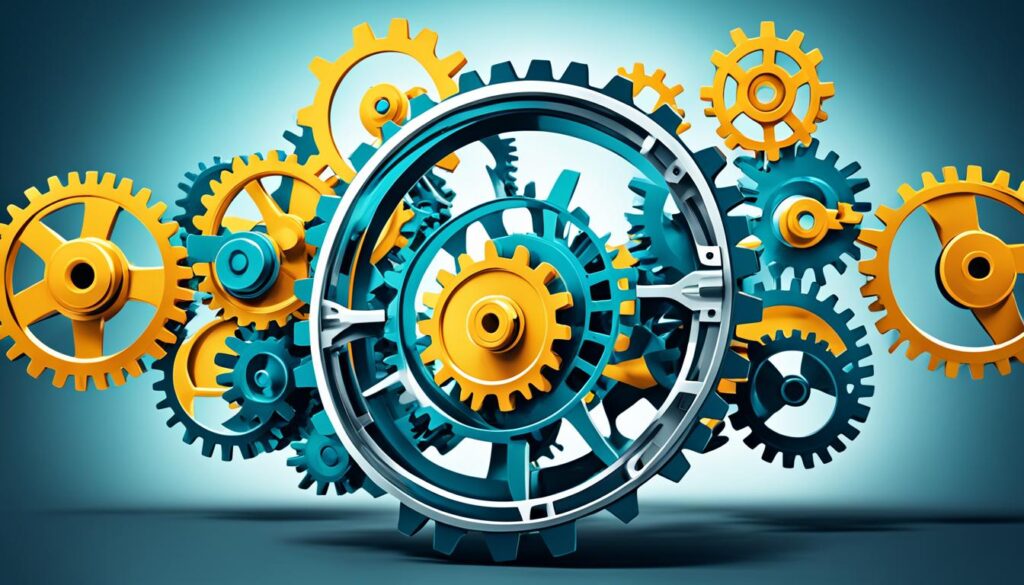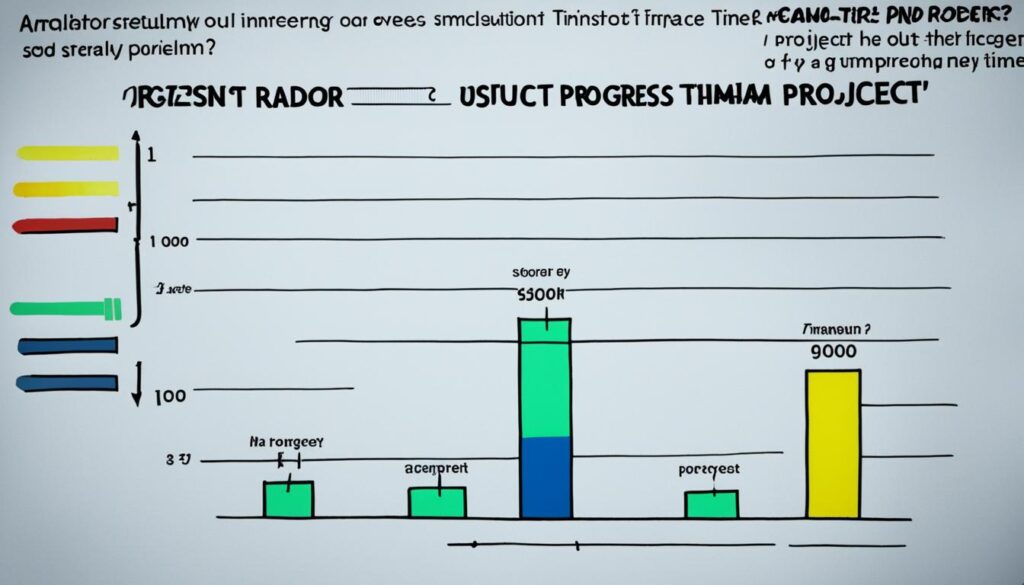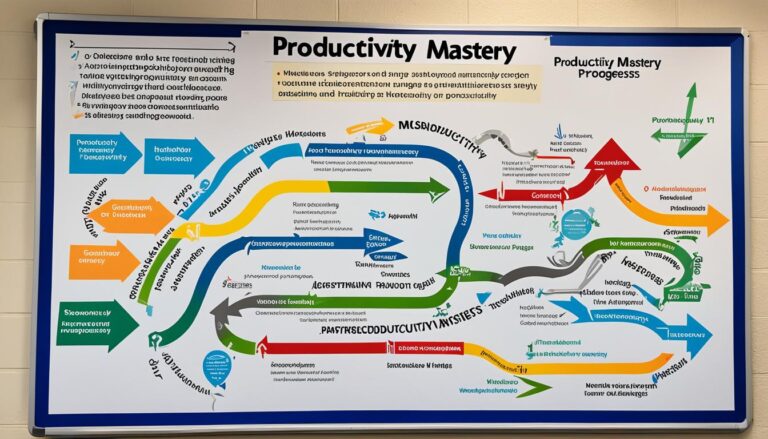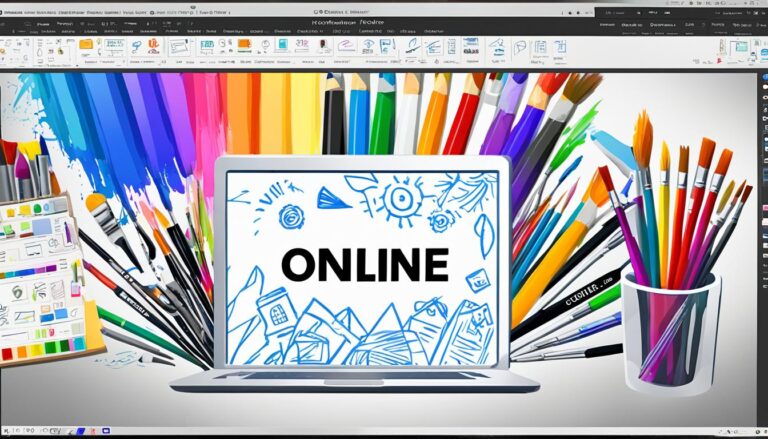Boost Your Team: How to Improve Employee Productivity

Do you ever wonder how some teams manage to consistently outperform others? How they effortlessly achieve outstanding results while maintaining high morale? The secret lies in their ability to boost employee productivity and maximize team efficiency. But how can you unlock this potential within your own team?
This article will reveal powerful strategies and proven methods to increase workplace productivity and elevate your team’s performance to new heights. By implementing these techniques, you can transform your team into a productivity powerhouse, driving success and achieving remarkable outcomes.
Key Takeaways:
- Setting clear expectations and empowering employees are key to improving productivity.
- Rewarding quality efforts and monitoring progress enhance employee performance.
- A healthy work environment and effective communication foster productivity.
- Leveraging strengths, promoting collaboration, and continuous learning drive team effectiveness.
- Implementing these strategies will maximize employee output and boost overall workplace productivity.
The Importance of Clear Expectations and Empowerment
When it comes to improving employee productivity, setting clear expectations and empowering your team members are key. By doing so, you can create a work environment that fosters efficiency and maximizes output.
Setting clear expectations is essential for guiding your employees’ actions and aligning their efforts with organizational goals. When team members have a clear understanding of their responsibilities and goals, they can prioritize and plan their work effectively. This clarity enables them to focus their energy on tasks that have the most impact, resulting in increased productivity.
Furthermore, empowering employees by giving them the autonomy to choose their own processes and tools can be incredibly empowering. When employees have the freedom to approach their work in a way that works best for them, they feel a sense of ownership and are more motivated to excel. This empowerment boosts their confidence, promotes creativity, and leads to improved productivity.
Streamlining work processes is another crucial aspect of enhancing productivity. By eliminating unnecessary steps and minimizing bottlenecks, you can create a smoother workflow that allows employees to complete tasks more efficiently. This streamlining also helps to avoid overload and prevent burnout, ensuring that your team members can focus on high-impact tasks without being overwhelmed.
Benefits of Setting Clear Expectations and Empowering Employees
- Improved focus and prioritization
- Increased motivation and engagement
- Enhanced creativity and problem-solving
- Reduced stress and burnout
- Higher quality work and improved efficiency
By setting clear expectations, empowering employees, and streamlining work processes, you can create a work environment where productivity thrives. Investing in these strategies will not only benefit your employees but will also lead to improved business outcomes and success.

Recognizing Quality Efforts and Monitoring Progress
When it comes to maximizing employee productivity, it’s important to focus on quality rather than solely on quantity. Rewarding and recognizing quality efforts can be a powerful motivator for your team members, encouraging them to consistently deliver their best work. By acknowledging their contributions and expressing appreciation for their efforts, you can boost morale and drive productivity.
Monitoring project progress plays a crucial role in ensuring that tasks are completed efficiently and effectively. Setting deadlines and regularly checking in on the progress allows you to keep everyone accountable and on track. This level of accountability not only maintains a sense of urgency but also helps identify any potential roadblocks or issues early on, allowing for timely adjustments and resolutions.

To effectively monitor project progress, consider using project management software or tools that allow for transparent collaboration and real-time updates. This way, you can easily track task progress, identify any bottlenecks, and make informed decisions to streamline workflows.
Here’s an example of a simple, yet informative, progress monitoring table:
| Task | Assigned To | Status |
|---|---|---|
| Research and Analysis | Emily | Completed |
| Design Prototypes | David | In Progress |
| Content Creation | Lisa | Not Started |
Regularly review progress, discuss any challenges or concerns, and provide the necessary support and resources to ensure the successful completion of tasks. This level of monitoring and support demonstrates your commitment to the project’s success and reinforces a culture of accountability within your team.
Creating a Healthy Work Environment and Encouraging Communication
A healthy work environment is crucial for fostering employee productivity and well-being. By prioritizing work-life balance, promoting well-being, and encouraging effective communication, you can create a workplace that nurtures high levels of engagement and maximizes team effectiveness.
Promoting Work-Life Balance
Work-life balance is essential for preventing burnout and ensuring that employees have the time and energy to invest in their personal lives. Encouraging a healthy balance between work and personal commitments allows individuals to recharge and maintain their overall well-being. By understanding and accommodating the diverse needs of your team members, you can promote a positive work-life balance for everyone.
Supporting Well-Being
Supporting the well-being of your employees goes beyond physical health. It involves creating an environment that prioritizes mental and emotional wellness. Providing opportunities for breaks and relaxation, implementing stress management programs, and offering resources for mental health support are all ways to promote employee well-being. When employees feel supported and cared for, they are more likely to be engaged and motivated.
Encouraging Effective Communication
Effective communication is the foundation of collaboration and productivity within teams and across departments. By promoting open, transparent, and respectful communication channels, you can ensure that information flows smoothly and that everyone is on the same page. Encourage active listening, provide platforms for sharing ideas and feedback, and foster a culture that values effective communication. When team members can express themselves and be heard, they can work together more efficiently and resolve any obstacles that may arise.

A healthy work environment and effective communication are key ingredients for boosting employee productivity and promoting overall well-being. By prioritizing work-life balance, supporting employee well-being, and encouraging open communication, you can create a workplace where your team can thrive.
Leveraging Strengths, Promoting Collaboration, and Continuous Learning
Identifying and leveraging the strengths of your team members can significantly boost productivity. When individuals are assigned tasks that align with their strengths, they become more engaged and perform at their best. By recognizing and utilizing their unique abilities, you can create a dynamic and efficient workforce.
In addition to harnessing individual strengths, promoting collaboration among team members is essential. By creating opportunities for open communication, idea sharing, and cross-functional teamwork, you can foster a culture of innovation and maximize productivity. Encourage your employees to collaborate and draw on each other’s expertise to tackle complex challenges and achieve exceptional results.
Continuous learning is a vital aspect of personal and professional growth. Invest in employee training programs that provide opportunities for skill enhancement and development. By empowering your team members with the knowledge and tools they need to thrive, you can create a motivated and high-performing workforce.
The Benefits of Leveraging Strengths, Promoting Collaboration, and Encouraging Continuous Learning
When you leverage strengths, promote collaboration, and encourage continuous learning within your organization, you unlock a range of benefits:
- Enhanced productivity and efficiency.
- Improved problem-solving capabilities.
- Increased employee satisfaction and engagement.
- Boosted creativity and innovation.
- Enhanced teamwork and collaboration.
- Reduced employee turnover.
By capitalizing on the unique strengths of your team members, fostering a collaborative environment, and investing in continuous learning, you create a culture of excellence that drives both individual and organizational success.
| Strengths | Collaboration Opportunities |
|---|---|
| Strong analytical skills | Lead data analysis projects |
| Excellent communication skills | Facilitate team meetings and promote effective communication |
| Creative thinking | Encourage brainstorming sessions and idea sharing |
| Organizational skills | Manage project timelines and ensure efficient workflow |

By identifying and leveraging the strengths of your team members, promoting collaboration, and providing continuous learning opportunities, you can cultivate a high-performance culture that drives productivity and success.
Conclusion
Improving work efficiency and maximizing employee output are essential goals for any business seeking to drive team effectiveness. By implementing effective management strategies and fostering a supportive work environment, you can unlock the full potential of your workforce and elevate your team’s performance.
To improve work efficiency, it is crucial to set clear expectations for your employees. When team members understand their responsibilities and goals, they can prioritize their tasks effectively, resulting in increased productivity. Recognizing and rewarding quality efforts, rather than solely focusing on quantity, will also motivate employees to deliver their best work consistently.
Creating a healthy work environment is vital in maximizing employee output. Promoting work-life balance and well-being ensures that employees remain engaged and prevent burnout, leading to improved productivity. Effective communication is equally important, as it enables seamless collaboration and quick resolution of any challenges that arise.
Investing in continuous learning and development opportunities for your employees is another key aspect of driving team effectiveness. By identifying and leveraging individual strengths, promoting collaboration, and providing training programs, you can enhance employee skills and productivity. Furthermore, continuous learning ensures that your team remains adaptable to changing business demands and industry trends.






